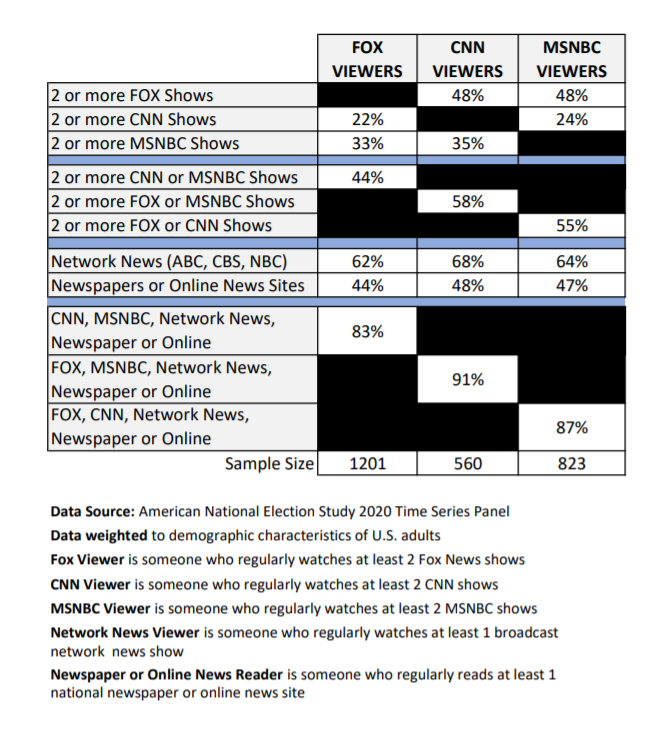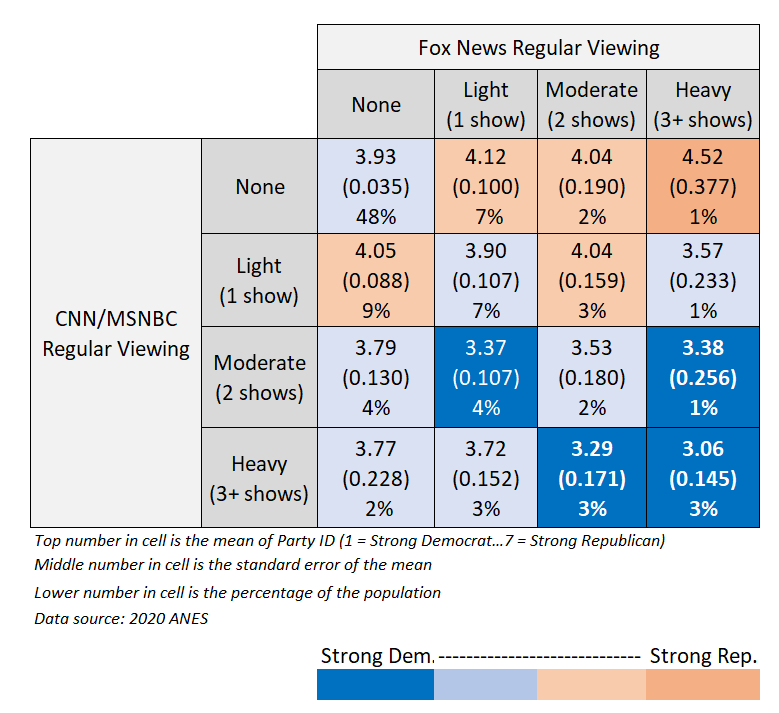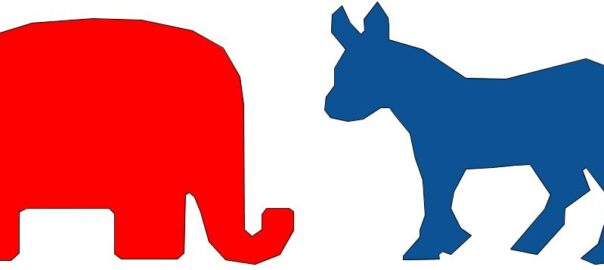By Kent R. Kroeger (Source: NuQum.com; February 6, 2022)
A popular political narrative in the U.S. news media is the story of a deeply polarized electorate where voters restrict their news consumption to partisan-friendly sources, avoid dissenting viewpoints, and remain loyal to their preferred party.
A November 2021 report by Pew Research summarizes this political landscape: “Partisan polarization remains the dominant, seemingly unalterable condition of American politics. Republicans and Democrats agree on very little — and when they do, it often is in the shared belief that they have little in common.”
In such a political landscape, major legislative compromises become rarer and important domestic and international problems remain unsolved.
Roll Call writer Stuart Rothenberg echoes this viewpoint: “Partisan polarization with two relatively equal parties takes its toll on the country and on voters. It is difficult for Washington to address important issues, since each side can essentially veto what the other wants to accomplish. And it breeds distrust of the opposition’s motives and allegiances.”
Gridlock isn’t all bad, however: Corporate America flourishes in this environment as tax and regulatory policies are more predictable since major changes to them are less likely — but that is an issue for a different essay.
How can we lessen our political divide?
One hypothesis on how our partisan divide will lessen over time — and thereby start the process to solve our nation’s most intractable problems (e.g., economic inequality, rising public debt, addressing climate change, rising health care costs, etc.) — assumes secular trends in national demographics will over time benefit one party (the Democrats) to the disadvantage of the other (the GOP).
But, if anything, recent evidence suggests the emerging Democratic majority may be the Democrats’ castle in the sky. Though he lost the 2020 election, Donald Trump increased his support among minorities compared to 2016, as the Democratic Party struggles to keep Hispanic and Black men in the fold.
Others political observers theorize that the paralyzing effects of extreme partisanship and political gridlock could give rise to a reform movement that crosses political lines and values compromise and civility over partisan rancor.
Writes Rothenberg: “…the resulting paralysis could eventually produce a reform movement — either inside one party or outside of the two parties — that would place a high priority on political compromise, civility and the rule of law.”
Political scientists Robert Putnam and Shaylyn Romney Garrett offer a more detailed description of this argument in their 2020 book The Upswing in which they argue our current political environment mirrors the Gilded Age (1890s) in terms of the conditions that preceded a long era of political consensus and reform — the Progressive Era (1896–1916).
The past is prologue, in their view.
How real is the partisan echo chamber?
Any conjecture on how this country will rediscover political harmony, however, must contend with a highly politicized media environment in which, according to some observers, few voters ever read or hear enough opposing points of view necessary to change their own points of view.
Research has generally found increases in an electorate’s political polarization relates to patterns in their media consumption. Its a symbiotic relationship where voters over their lifetime tend to restrict their news consumption to news sources aligned with their preferred political attitudes.
It is not necessarily a straightforward relationship, however. For example, research has found that exposure to opposing viewpoints on social media can increase a voter’s political polarization, not lessen it.
Still, on average, conservative Republicans are more likely to watch Fox News while Democrats turn to CNN or MSNBC.
But is this characterization accurate?
Based on evidence from the 2020 American National Election Study (ANES), I conclude that the partisan echo chamber assumption is inaccurate and misrepresents a common tendency among Americans to watch, listen and read news from more than one partisan perspective.
While 48 percent of Americans do not regularly watch cable TV news (CNN, MSNBC, or Fox News), the other 52 percent do so and most of them do it across the partisan spectrum, according to the 2020 ANES.
Any attempt to explain the growth in political polarization (or conjecture how to lessen it) cannot rely on the belief that most voters lack exposure to alternative points of view as expressed in the news media. Most Americans who regularly consume cable TV news do so from media outlets across the political divide.
The partisan echo chamber is more myth than reality
The 2020 ANES asked 8,280 U.S. adults which television programs they regularly watch at least once a month. Using that information, I defined three cable TV news viewer categories based on whether they regularly watch at least two news shows on that network each month. Accordingly, a Fox News Viewer is someone who watches at least two Fox News shows each month, a CNN News Viewer watches at least two CNN shows each month, and an MSNBC Viewer watches at least two MSNBC shows each month.
[Note that the three viewing groups as I defined them— Fox News viewers, CNN viewers, and MSNBC viewers — are not mutually exclusive categories. Some ANES survey respondents belong to two or more of those groups.]
Figure 1 (below) shows the extent to which these three cable TV news viewing groups watch other cable TV news networks. If you believe most Americans who watch cable TV news limit their viewing to sources aligned with their personal political views, the following results are enlightening.
In reality, 22 percent of Fox News viewers regularly watch two or more CNN shows and 33 percent watch two ore more MSNBC shows. Likewise, 48 percent of CNN and MSNBC viewers regularly watch two or more Fox News shows.
Forty-four percent of Fox News viewers regularly watch two or more CNN or MSNBC shows.
Figure 1: Cross-network viewing among regular viewers of the three cable TV news networks (Fox, CNN, and MSNBC)

If we expand our news universe to the broadcast networks (CBS, NBC, ABC, PBS) and online news sites (Bloomberg News, Huffington Post, NPR, New York Times, USA Today, Washington Post, and Yahoo News), 83 percent of Fox News viewers tap into these news sources on a regular basis, compared to 91 percent of CNN viewers and 87 percent of MSNBC viewers.
The oft-repeated assumption that the average Fox News viewer lives in a (mis)information bubble that reinforces pro-Republican, conservative talking points is wholly inaccurate. Surprisingly, Fox News viewers routinely reach across the ideological divide for their cable news consumption, as do half of CNN and MSNBC viewers.
The 2020 ANES media consumption data do not allow for a comprehensive volumetric analysis but it still offers tangible evidence refuting the assumption that Americans live in their own personal “news and information bubble.”
Most Americans who routinely consume cable TV news do so by distributing their consumption across the mainstream political spectrum.
The strange interactions of Fox News, CNN and MSNBC viewership
If we sum the number of cable TV news network shows regularly watched by network for each 2020 ANES respondent, we can roughly approximate their viewing volume.
Thus, I categorized Fox News and CNN/MSNBC viewers into one of four volumetric categories: No Cable TV news viewing (0 shows), Light viewing (1 show), Moderate viewing (2 shows) or Heavy viewers (3 or more shows). I then crossed their cable news viewing status with their party identification (Party ID), which was measured on a 7-point scale where 1 = Strong Democrat and 7 = Strong Republican. Hence, any cell in Figure 2 with an average Party ID over 4 is considered to be “Republican-leaning,” while an average below 4 indicates “Democrat-leaning.”
The results of this analysis (in Figure 2) are illuminating, as well as puzzling.
First, as seen in the upper-left-hand cell in Figure 2, almost half of Americans (48%) do not watch CNN, MSNBC or Fox News.
Figure 2: Cross-network viewing among regular viewers of the three cable TV news networks (Fox, CNN, and MSNBC)

Concentrating on the first row in Figure 2 (i.e., people who do not regularly watch CNN or MSNBC), as regular viewing of Fox News increases, the probability of being a strong Republican also increases. Among heavy Fox News viewers who do not watch CNN or MSNBC, the average Party ID is 4.52 — the strongest Republican group among the 16 cells in Figure 2. That makes intuitive sense.
Also notice that only one percent of U.S. adults are heavy Fox News viewers who do not watch any CNN or MSNBC shows. But if we look at the counterpose cases in the first column of Figure 2 (i.e., people who do not regularly watch Fox News), there is not a clear linear trend in Party ID. Light CNN/MSNBC viewers who do not watch Fox News skew slightly Republican (avg. Party ID score = 4.05), but among heavy CNN/MSNBC viewers, the average Party ID score decreases to 3.77 — a difference that is not statistically significant, but is in the expected direction.
But now where things get strange…
Column 4 in Figure 2 contains heavy Fox News viewers (3+ shows). As noted, the most Republican group in Figure 2 is heavy Fox News viewers who do not watch CNN or MSNBC. No surprise there.
Also expected, as CNN/MSNBC viewing goes up, the average Party ID becomes more Democrat — going from an average Party ID score of 4.52 to 3.06 in the bottom right-hand cell.
But among heavy CNN/MSNBC viewers (the fourth row in Figure 2), the average Party ID gets progressively more Democrat as we increase Fox News consumption, going from a score of 3.77 (heavy CNN/MSNBC viewers who do not watch Fox News) to a significantly lower score of 3.06 among people who are heavy viewers of CNN/MSNBC and Fox News.
What the heck?! Among CNN/MSNBC viewers, increased Fox News viewing is associated with an increased chance of someone being a strong Democrat?
My first reaction is to assume I coded the variables wrong. But after a series of check-double-check routines, I could not find a coding mistake (Note: My SPSS code and dataset are available on GITHUB here — feel free to double check my work).
My second hunch is that we are looking at ‘News Junkies’ in the lower right-hand cell and perhaps they are just more likely to be strong Democrats than strong Republicans. But what social or pyschology theory explains that asymmetry?
Earlier in this essay I cited a 2018 study that found political partisans who are exposed to opposing viewpoints on social media tend to, on average, become more partisan. The authors of the study write: “Republican (study) participants expressed substantially more conservative views after following a liberal Twitter bot, whereas Democrats’ attitudes became slightly more liberal after following a conservative Twitter bot — although this effect was not statistically significant.” Explanations these researchers offered to explain their results included:
(1) A ‘backfire’ effect where “people who are exposed to messages that conflict with their own attitudes are prone to counterargue them using motivated reasoning, which accentuates perceived differences between groups and increases their commitment to preexisting beliefs.”
(2) the relative anonymity of social media “emboldens people to act in an uncivil manner…in the absence of facial cues and other nonverbal gestures that might prevent the escalation of arguments in offline settings” and thereby reinforces preexisting partisan preferences.
(3) An asymmetric version of the ‘backfire” effect where, because conservatives hold values that prioritize certainty and tradition, compared to liberals who value change and diversity, conservatives are more likely to act defensively to opposing information.
All of these explanations sound a bit hobbledy-gobbledy-goo to me, but until I hear better ones, I’ll accept their hypotheses.
But if I could offer my own hypothesis as to why this ‘backfire effect’ might operate more on Democrats more than on Republicans, it would go something like this:
Mainstream media content, especially within entertainment TV, movies, music, etc., is overwhelmingly oriented towards liberal social values and narratives. The natural consequence of this intrinsic bias is that anyone who increases their media consumption will get their liberal beliefs reinforced more often than someone with conservatives beliefs. That there are people who are heavy viewers of CNN/MSNBC and Fox News — an apparent contradiction — may simply be an artifact of their heavy consumption of all media.
The ANES 2020 data on media consumption lacks the breadth and fidelity to address these hypotheses as to why increased Fox News viewing might increase partisan polarization among Democrats, but increased viewing of CNN/MSNBC among Republicans might soften the partisan divide.
I suspect the mechanisms at play are far more profound than simply assuming CNN and MSNBC are persuasive while, to the sane, Fox News comes across as batshit crazy. As I hope I’ve demonstrated over the years I’ve written about politics and news, there is plenty of batshit crazy to go around for both political parties and their propaganda outlets.
Final thoughts
The main thesis of this essay is that a significant number of Americans do not live in a partisan media bubble, though a near majority eschew cable news in general. Notably, the vast majority of regular Fox News viewers consume news across the political divide. Likewise, almost half of CNN/MSNBC viewers watch Fox News on a regular basis.
The partisan echo chamber is more myth than reality.
As a result, there remain substantive avenues through which partisan political actors and their surrogates can create significant opportunities for opinion change within the voting public.
However, even with this potential for persuasion to occur, it may be more likely to benefit the Democrats than Republicans. The 2020 presidential election may be the textbook example of this dynamic.
In a study of the 2020 presidential election conducted by Harvard University’s Shorenstein Center on Media, Politics, and Public Policy, a content analysis of CBS News and Fox News coverage of the presidential election found that almost 90 percent of CBS’s statements towards Joe Biden were positive, while only five percent were for Donald Trump. Conversely, Fox News was positive towards Biden and Trump at roughly the same rate (41 and 42 percent, respectively).
From the ANES 2020 data, we know that many loyal Fox News viewers were exposed directly to CBS News’ 2020 election coverage, as well as coverage from other establishment news outlets with a discernable anti-Trump bias (e.g., CNN and MSNBC).
Could this have had an effect on the 2020 outcome, not just by discouraging voter turnout among weak Trump supporters (and encouraging turnout by weak Biden supporters), but also through genuine opinion change?
Since a large number of Americans do not live in the oft-assumed partisan echo chamber, the answer to this question is likely Yes!
- K.R.K.
Send comments to: kroeger98@yahoo.com
